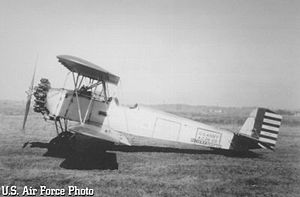Consolidated PT-3 Video - Picture

|
|
Consolidated PT-3
PT-3

Picture - Consolidated PT-3
Role: Trainer
Manufacturer: Consolidated Aircraft Company
Introduced: 1927
Primary user: United States Army Air Corps
Produced: September 1927
Number built: 250
Variants: Consolidated NY, Consolidated O-17
The Consolidated Model 2 was a training airplane used by the United States Army Air Corps, under the designation PT-3 and the United States Navy under the designation NY-1.
Development
Seeing the success of the Navy's NY-1 modification of a PT-1 airframe, the USAAC came to the conclusion that a radial engine was indeed ideal for a trainer. It was reliable and offered a good power to weight ratio. Therefore one PT-1 airframe was completed as XPT-2 with a 220 hp (164 kW) Wright J-5 Whirlwind radial engine.
The XPT-3 was almost identical with the XPT-2 except for the tail, revised wing panels and different shape. One hundred and thirty production PT-3 aircraft were ordered in September 1927, with one being completed as the XO-17. These were followed by one hundred and twenty PT-3A aircraft with minor changes. The XPT-3 became the XPT-5 when fitted with the Curtiss Challenger R-600 two-row 6-cylinder radial engine, but was soon converted to PT-3 standard.
The PT-3 aircraft were superseded by the Boeing PT-13 Stearman starting in 1937, but a number were still operational with the Spartan Flying School in Tulsa Oklahoma into the middle of World War II.
Variants
XPT-2
one PT-1 airframe with a 220 hp (160 kW) Wright J-5 (R-790) radial engine, wingspan 34 ft 7 in (10.5 m), length 28 ft 4 in (8.6 m), gross weight 2,427 lb (1100 kg)
XPT-3
one PT-1 airframe with revised wing panels (Clark "Y" wings) and a different vertical tail, wingspan 34 ft 6 in (10.5 m), length 28 ft 3 in (8.6 m), gross weight 2,439 lb (1106 kg)
PT-3
130 ordered, one completed as the XO-17 prototype, gross weight 2,481 lb (1125 kg)
PT-3A
120 ordered with minor updates, Wright J-5, gross weight 2,432 lb (1103 kg)
XPT-4
unbuilt, was to be a development PT-3 with the experimental Fairchild-Caminez 447C engine
XPT-5
the airframe of the XPT-3 was temporarily fitted with the Curtiss Challenger R-600-1 two-row 6-cylinder radial engine in 1929, later converted to PT-3 standard
Operators
Cuba
four PT-3s
Argentina
one PT-3
Brazil
one PT-3
Peru
one PT-3
Mexico
a small number may have been sold to Mexico
United States
United States Army Air Corps
United States Navy
United States Marine Corps
Specifications (PT-3)
Data from "United States Military Aircraft Since 1908" by Gordon Swanborough & Peter M. Bowers (Putnam Newy York, ISBN 0370000943) 1977, 675 pp.
General characteristics
Crew: Two
Length: 28 ft 1 in (8.56 m)
Wingspan: 34 ft 6 in (10.52 m)
Height: 10 ft 3 in (3.12 m)
Wing area: 300 ft (27.87 m)
Empty weight: 1,785 lb (810 kg)
Max takeoff weight: 2,481 lb (1,125 kg)
Powerplant: 1x— Wright R-790-AB radial, 220 hp (164 kW)
Performance
Maximum speed: 102 mph (164 km/h)
Cruise speed: 81 mph (130 km/h)
Range: 300 miles (483 km)
Service ceiling: 14,000 ft (4,267 m)
Rate of climb: 658 ft/min (200 m/min)
Consolidated PT-1 "Trusty"
Consolidated O-17
Consolidated PT-11
Consolidated PT-3 Pictures
Living Warbirds: The best warbirds DVD series.
Source: WikiPedia